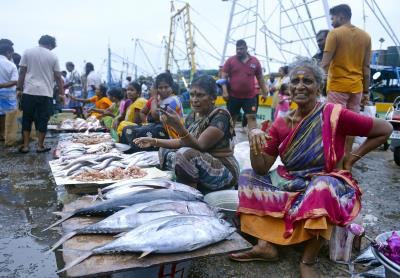GST Rate Cut Across Fisheries Value Chain To Boost India's Blue Economy: Govt
Under the revised structure, GST on fish oils, fish extracts, and prepared or preserved fish and shrimp products has been reduced from 12 per cent to 5 per cent, making value-added seafood more affordable for domestic consumers and enhancing the competitiveness of India's seafood exports, said Ministry of Fisheries, Animal Husbandry and Dairying.
Diesel engines, pumps, aerators, and sprinklers, essential for aquaculture operations and hatcheries, will now attract only 5 per cent GST instead of the earlier 12 to 18 pe rcent, significantly reducing operational costs for fish farmers. Critical chemicals such as ammonia and micronutrients used in pond preparation and water quality management will also be taxed at 5 per cent, down from the earlier 12 to 18 per cent, cutting costs of feed, pond conditioning, and farm-level practices.
Reduced GST on preserved fish, shrimp, and molluscs will strengthen India's seafood exports globally while promoting greater domestic consumption of safe and hygienically processed seafood. The GST rate on fishing rods, tackle, landing nets, butterfly nets, and gear has been reduced from 12 per cent to 5 per cent, benefiting both recreational, sport fishing as well as small-scale aquaculture and capture fisheries farmers. This will make essential gear more affordable, lowering input costs and supporting livelihoods in the sector.
The decision further provides relief to processing units, with GST on job work services in food and agro-processing, including seafood, cut from 12 per cent to 5 per cent. Composting machines, vital for producing organic manure and ensuring eco-friendly pond management, will now be taxed at 5 per cent, encouraging sustainable aquaculture practices, said the ministry.
India's fisheries and aquaculture sector has emerged as one of the fastest-growing in the world, contributing significantly to food and nutritional security, farmer incomes, rural livelihoods, and exports. The sector today supports the livelihood of over 3 crore people and has positioned India as the second-largest fish producer globally with a production of nearly 195 lakh tonnes (2024-25).
India is also the largest shrimp exporter in the world, with seafood exports crossing Rs. 60,000 crores in 2023-24, thereby earning valuable foreign exchange and strengthening the nation's Blue Economy.

Legal Disclaimer:
MENAFN provides the
information “as is” without warranty of any kind. We do not accept
any responsibility or liability for the accuracy, content, images,
videos, licenses, completeness, legality, or reliability of the information
contained in this article. If you have any complaints or copyright
issues related to this article, kindly contact the provider above.
Most popular stories
Market Research

- Daytrading Publishes New Study On The Dangers Of AI Tools Used By Traders
- Primexbt Launches Empowering Traders To Succeed Campaign, Leading A New Era Of Trading
- Wallpaper Market Size, Industry Overview, Latest Insights And Forecast 2025-2033
- Excellion Finance Scales Market-Neutral Defi Strategies With Fordefi's MPC Wallet
- ROVR Releases Open Dataset To Power The Future Of Spatial AI, Robotics, And Autonomous Systems
- Ethereum-Based Meme Project Pepeto ($PEPETO) Surges Past $6.5M In Presale






















Comments
No comment